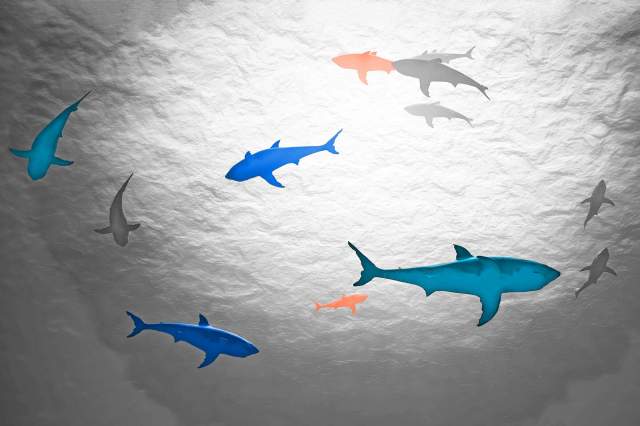
Sharks Are Older Than Trees
Sharks evolved more than 450 million years ago — long before trees or Tyrannosaurus rex appeared on Earth. The earliest sharks were probably toothless and, like today’s sharks, had cartilaginous skeletons; they may have resembled fish called chimeras that still live in the deep ocean.
The first shark that really looked shark-like appeared around 380 million years ago in the Devonian period. Just a few million years later, a major extinction wiped out many species that competed with sharks, allowing them to evolve rapidly into numerous new shapes, sizes, and ecological niches — some of which are still around. One of the oldest species living today is the bluntnose sixgill shark, which evolved between 200 million and 175 million years ago in the early Jurassic epoch.

We Have Learned a Lot From Shark Teeth
As cartilaginous fishes, sharks don’t leave much behind when they die. Known shark fossils consist mainly of teeth and a handful of scales, vertebrae, and impressions left in rock. Even so, paleontologists have been able to identify about 2,000 species of extinct sharks just by examining differences in fossilized teeth. For example, the oldest shark teeth ever found came from an Early Devonian fish dubbed Doliodus problematicus; bits of its fossilized skeleton showed characteristics similar to bony fishes, while its teeth and jaw were more shark-like, confirming a theory that the species was an ancient ancestor of sharks.

There Are More Than 500 Species of Sharks in the World
Sharks are categorized into nine taxonomic orders. To name a few of the most recognizable types, Carcharhiniformes, the order of ground sharks, encompasses over 290 species, including the bull shark, tiger shark, blue shark, hammerhead, and more. The great white shark, basking shark, and makos, as well as the aptly named goblin shark and other species, belong to Lamniformes — also known as mackerel sharks. The carpet shark order, Orectolobiformes, includes the whale shark, nurse shark, wobbegong, and others. In all, there are more than 500 species of sharks swimming the world’s water.
More Interesting Reads

There’s a Huge Size Difference Between the Largest and Smallest Sharks
With so many shark species swimming Earth’s oceans, there’s incredible variation in their sizes. The largest shark species living today is the whale shark (Rhincodon typus), a gentle, plankton-eating giant that can grow to 45 feet long or more and weigh 20 tons (the biggest accurately measured whale shark reached 61.7 feet!). They can be found in all of the world’s tropical seas. The smallest known shark species, meanwhile, was discovered in 1985 off the coast of Colombia in the Caribbean Sea: The dwarf lantern shark (Etmopterus perryi) averages a length of just under 7 inches. It dwells in the ocean’s twilight zone, about 1,000 feet below the surface, but sometimes feeds in the shallows and uses bioluminescent organs along its belly to camouflage itself against sunlit waters.

Sharks Have a Sixth Sense
Like all fishes, sharks have a sensory organ called the lateral line running down the length of their bodies. The lateral line system involves exterior pores and specialized cells that can detect vibrations in water, which helps sharks locate prey from hundreds of feet away. In addition to sensing water movements, sharks can perceive electric fields surrounding other animals (the fields are caused by the animals’ muscle contractions). This sixth sense, called electroreception, picks up electrical signals that sharks can use to home in on prey. Electroreception can also guide migrating sharks via Earth’s electromagnetic fields.

One Shark Species Can Live for Centuries
The slow-growing, Arctic-dwelling Greenland shark (Somniosus microcephalus) is not only the longest-lived shark, but also holds the record for the longest-lived vertebrate on Earth. Unlike other sharks, Greenland sharks don’t have cartilage that shows their growth over time, so scientists have had difficulty estimating their age accurately. In 2016, a study in the journal Science described how a team of biologists carbon-dated eye proteins, which build up continuously during the animals’ lives, in several Greenland sharks. They found the individuals were an average of 272 years old when they died, and the results suggested that the sharks’ maximum life span could be up to 500 years.

You’re More Likely To Be Killed by a Cow Than a Shark
Your risk of suffering a shark attack is practically nil. For its 2022 global summary, the Florida Museum of Natural History’s International Shark Attack File confirmed 57 unprovoked shark bites in 2022, meaning they happened when humans were simply in the shark’s natural habitat, and 32 provoked attacks, such as when people were feeding or harassing the fish. Forty-one of the unprovoked attacks occurred in the U.S., and one was fatal. Other animals are way more likely to kill you, including cows (which kill an average of 20 Americans a year, according to CDC data), hornets, bees, and wasps, (about 48 people a year) and dogs (around 19 a year).











